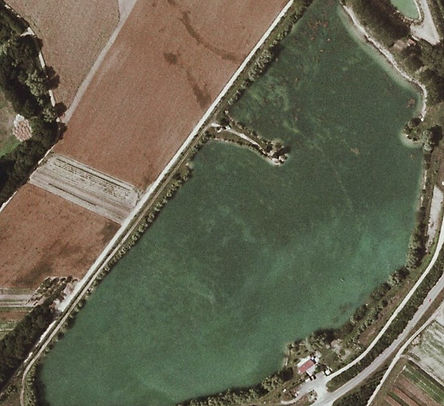
The Carp lakes
The Graviers consists of two Gravel pits, located in the Cote d'or region of France, not far from Dijon.The Main lake is around 25+ acres, and was extracted back at the end of the 1970's early 80's, and the Long lake is around 5 acres and was extracted in 2001.

The Main lake
Depths of around 10/11 feet, and an excellent water quality, the Main lake has already produced some remarkable fish. The Long lake is slightly shallower and is now also producing some quality carp too.
The age of some of the Main lake Carp has been determined via professional scale readings from an English University. Amazing results have shown incredible growth rates, for this relatively "new" lake, especially when compared to other waters from other areas in France.
The Graviers Tic Hook
click image to find out more..



It just goes to show that the age of a water has no real influence on the growth capability of the fish within it, in fact, a "new" water with the right make up, is probably a far more beneficial environment as it's natural resources have not been exhausted.
History
The extraction of the Main lake started back in 1979, when the local community decided to exploit the gravel deposits found in the area, which were used mainly in the construction of the auto route. The lake was in fact formed in 3 separate stages, over a period of around 11 years in total, with completion being around 1990 when the lake finally acquired the distinctive shape it has today.
The pits in the area were extracted via the use of large 360 diggers as opposed to drag lines which tend to be used on the larger extractions. The gravel was transported by means of conveyer belts to a centrally located depot, where it was cleaned, graded and stocked.
Strict regulations determined the exact volume of gravel extracted in any of the pits in the region, which in turn dictated the size and depths of these gravel pits as we find them today, and is also the reason the lakes in the area tend not to have many of what anglers term as features, i.e. bars, holes, plateau's etc.
By the end of the 80's the lake had become very popular with the people of Dijon for swimming and sunbathing, probably because of the very high water quality. It was about this time in fact that the original restaurant was built on the lake, and the owner created his business based on the popularity of the aquatic activities, introducing Pedalos, boats, swimming, Donkey rides, diving board, table tennis, etc. A thriving business at the time, but was soon to be affected by the changes in the law concerning public safety. Eventually, all the other activities ceased, and only the restaurant remained open.
Click onto the images below to see more details....

After the 1st stage of the extraction, and only a 3rd of it's present size, you can see the bright white exposed gravel at the waters edge, and a ploughed field in the centre. The lake was already used by local people for swimming, due to the quality of the water.

The 2nd stage of the excavation, just prior to the construction of the auto route, and another 3rd of the gravel has been removed, forming the famous point. Again the remaining gravel is the white area you can see with rough scrub land in the middle of that. If you look carefully, in this image you can see the hundreds of people and cars around the waters edge, the lake was very popular for swimming and sunbathing.

Here the extraction has not long been completed, this you can tell by the lack of vegetation around the perimeter. This is just prior to the construction of the original restaurant, but you can see the brand new A31 auto route has been completed.

In this image both the Auto route, and the restaurant have been up and running for some years. The lake itself has also matured nicely, with a substantial tree line already formed. Very limited angling at the lake during this period, as in fact the restaurant owner seemed to been unaware of potential of the fishing.
Original stocking
It has proved impossible to find out exactly at what stage the lake was originally stocked, but, based on the age of the Carp from the scale readings taken, we presume the fish were introduced once the lake excavation had been completed, around end of the 80's to early 90's.
The Carp and other species such as Roach, Rudd, Pike and Zander, were most probably supplied by a local Piscaculture to the local communities, who were in fact responsible for stocking the pits they had created. The carp stock would have been bread, and grown on by the Piscaculture in his local etangs, and probably sold on after 3 seasons.
Until Winter 2017...the stock of Carp at the lake had not been added to. I have now decided to add some quarantined fish to stimulate feeding activity, with the hope of increasing the number of bites during the slower weeks at the lake.. Take a look at the News page to see more, including photos.
Recently, I have been lucky enough to acquire video footage of the Carp at the lake prior to my arrival here. It's amazing to see all of the fish at considerably smaller sizes than they are now... it's evidence of the weight gains that some of the fish have shown since our fishery management program was applied.
